Georgina Campbell's Cookery Feature - Up the Ante in Your Cooking with Beer & Cider
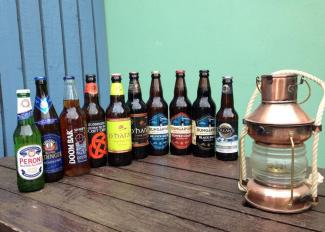 Craft drinks production is growing at such a dizzying speed that it seems that every place in Ireland now has at least one local speciality beer or cider to its name - and perhaps a gin, whiskey, vodka or poitín too.
Craft drinks production is growing at such a dizzying speed that it seems that every place in Ireland now has at least one local speciality beer or cider to its name - and perhaps a gin, whiskey, vodka or poitín too.
While, as is to be expected, some are better than others, the best will earn recognition and thrive. In addition, the surrounding creativity, production and employment is giving a terrific boost to local communities and making the ideal complement to the vibrant speciality food sector that is now central to our everyday lives - and our shopping habits.
As this new drinks sector grows, it’s interesting to see innovative developments emerging. An especially welcome one is the pride that some of the leading cider producers are showing in their product, by using classy design and different shaped bottles to underline the quality of the contents and encourage shoppers to think of it in the same way as wine - to be shared at the table, as an accompaniment to good food.
Similarly, we could all be thinking a lot more creatively about the ways in which craft drinks can be used in cooking. Used well, to complement our great local foods, they can be instrumental in developing a more varied yet clearly defined sense of place in the dishes that we’re offering to visitors to every area of the country.
Here at the Guide, we’re just starting another season of touring the country, ‘dining for Ireland’. This year, as usual, we’ll visit every county in Ireland at least once and it would be lovely to find some more creative menus with real local flavours, especially in pubs and casual dining situations where menus are so often disappointingly the same from one end of the country to the other.
The recipes below are taken from Caroline Hennessy and Kristin Jensen’s super book Sláinte, The Complete Guide to Irish Craft Beer and Cider (New Island, €19.99), which has a chapter on cooking with beer and cider.
Some of the recipes are a little long, but that’s because they’ve thought of everything, so the less experienced cook can have a go without having to second-guess the instructions (or the results).
The ideas may not all be new (in my own books going back to the early’90s I made a point of using Irish drinks, especially cider, in recipes like these), but they have been reworked to have particular relevance to today’s craft drinks scene and the great range of recipes given should be an inspiration to cooks and chefs throughout the country. They can easily be adapted, or simply used as a starting point for other dishes that could, one day, become local specialities.
Wouldn’t it be great to settle into a cosy bar or a characterful café and have something like this deliciously simple Cheddar, Chive and Red Ale Bread served with a sensationally seasonal bowl of soup? Or the steaming bowl of mussels, with a good Irish craft cider giving a tasty twist on the classic combination? The Beef, Beer and Blue Cheese Pot Pies would be perfect pub fare, and Imen McDonnell’s variation on fish&chips should give plenty to think about.
The possibilities are endless - and Sláinte is a very good place to begin.
RECIPES:
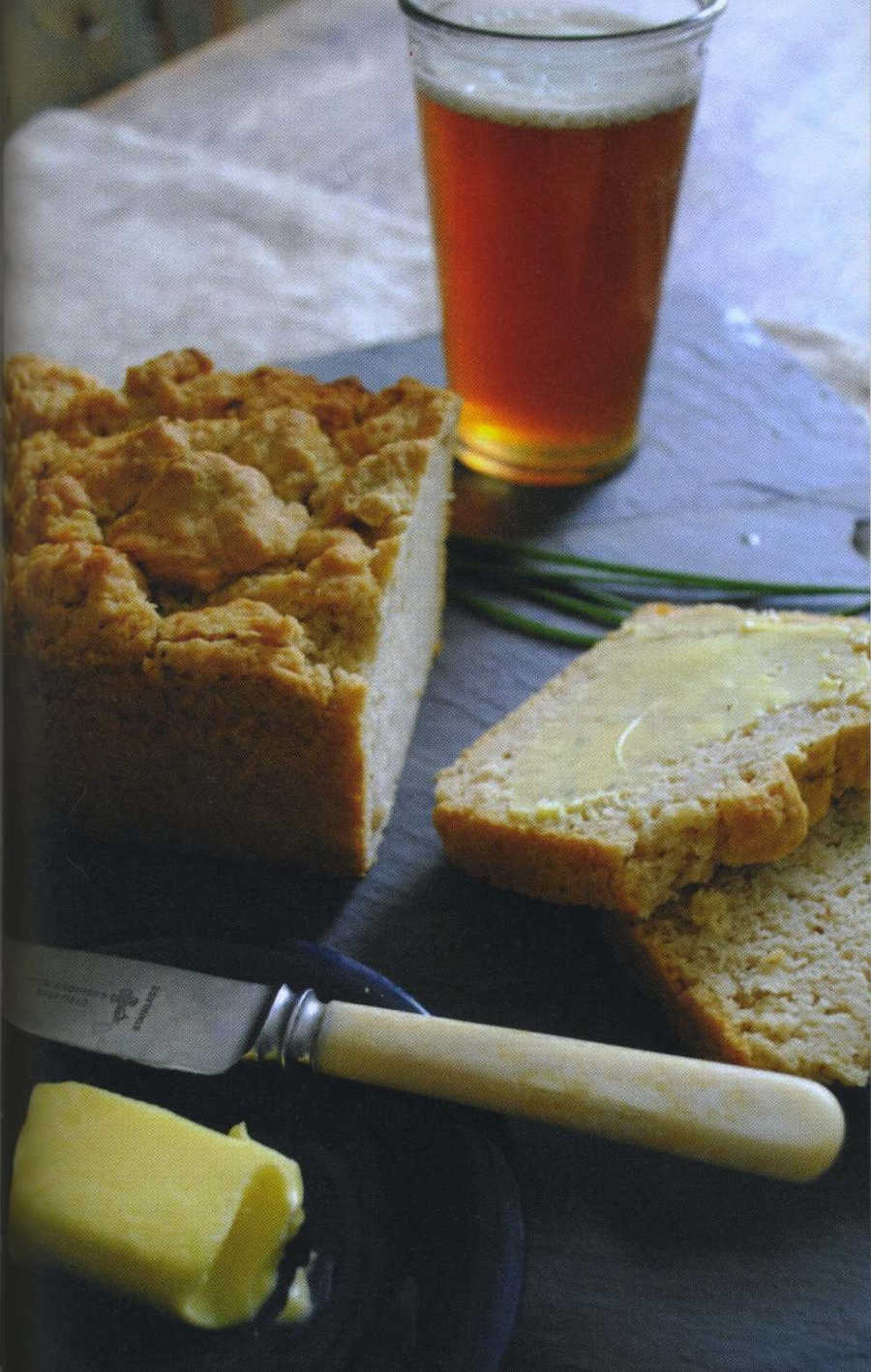 Cheddar, Chive and Red Ale Bread
Cheddar, Chive and Red Ale Bread
Makes 1 x 450gloaf
“A cheese and beer bread is only as good as the ingredients. This version uses a well-flavoured mature farmhouse Cheddar, like Hegarty's, Coolattin (Supreme Champion at the 2015 Irish Cheese Awards) or Mount Callan, along with a red ale from 5 Lamps Brewing, O'Hara's or try Porterhouse stout (or even a medium-dry cider). Other variations to play around with are blue cheese and sage; or try goat's cheese, pale ale and thyme.”
50g butter, plus extra for greasing
50g strong Cheddar cheese
350g plain flour
1 tablespoon baking powder
1 teaspoon salt
1 teaspoon granulated sugar
handful of finely chopped fresh chives
330ml red ale
Preheat the oven to 190°C (170°C fan). Thoroughly butter and flour the base and sides of a 450g loaf tin.
Melt the butter, grate the cheese and set both aside.
Sift the flour, baking powder and salt into a large bowl. Add the grated cheese, sugar and chives. Mix thoroughly and make a well in the centre; Pour in the ale and stir gently, until just combined.
Scrape into the loaf tin, pour over the melted butter and cook in the oven for 50-60 minutes, until well browned. Slip it out of the tin - if the loaf is ready, the base will sound hollow when you tap it with your knuckles. If not, return it to the oven without the tin for 5 more minutes.
Cool on a wire rack - if you can resist! - before cutting and serving with bowls of chunky lentil soup.
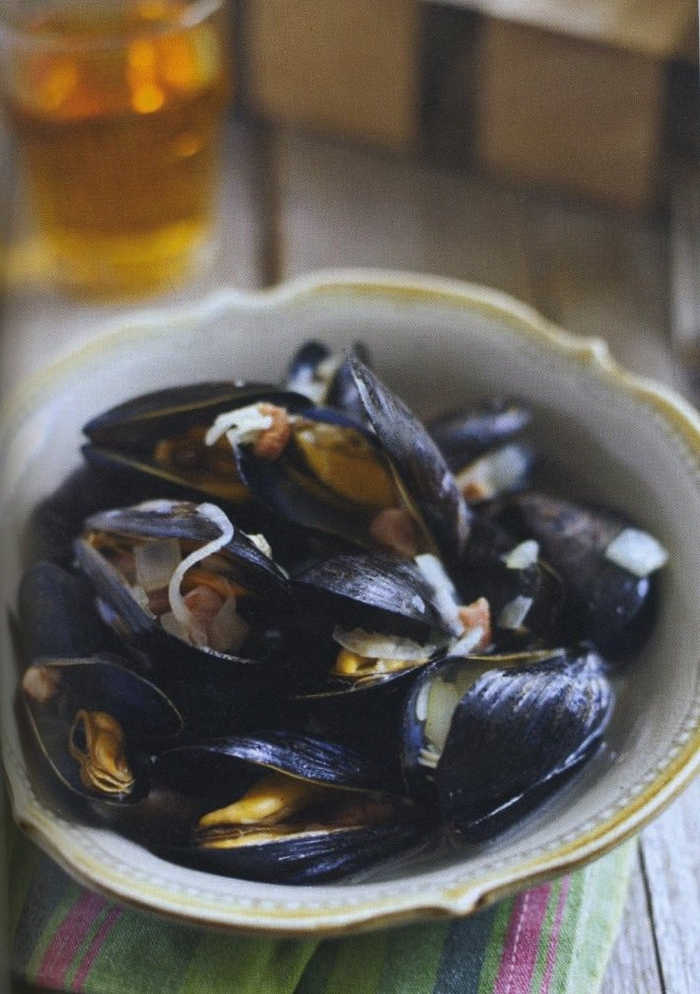 Mussels with Bacon and Irish Cider
Mussels with Bacon and Irish Cider
Serves 4
“TV cook and author Donal Skehan says that mussels have a reputation for being difficult, but this is just not true. In reality, the hardest part is washing them. Place them in cold water (they should close - if they don't, throw them away). Scrub any dirt off the surface of the mussels and remove the beard with a small knife. If you can get this done, you won't have any trouble. They take minutes to cook, so they are the perfect little starter. Serve the pot straight to the table from the stove and serve large spoonfuls of the cooked, steaming mussels onto guests' plates. Make sure to serve with some chunky bread to mop up the juices.”
200g pancetta pieces or diced bacon
knob of butter
1 medium onion, finely chopped
3 garlic cloves, crushed
400ml medium or sweet cider
1.5kg mussels, washed and beards removed
4 tablespoons cream
handful of chopped fresh parsley
sea salt and freshly ground black pepper
crusty bread, to serve
Discard any mussels that are open before cooking and any that stay closed after cooking.
Place a large pot over a high heat and brown the pancetta pieces until just golden and sizzling. Reduce the heat to medium, add in the knob of butter and allow it to melt. Add the chopped onion and cook gently for about 5 minutes, covered, until soft but not browned. Stir in the garlic and cook, uncovered, for 1 minute more.
Pour in the cider and allow it to bubble away for a few minutes so that the flavours mingle together. Add in the mussels, cover the pot with a lid and allow them to steam for about 4 minutes, until they open. Give the pot a good shake once or twice during the cooking time.
Remove from the heat, stir in the cream and parsley and season with se salt and ground black pepper. Serve with some crusty bread to mop up the salty, cidery liquid.
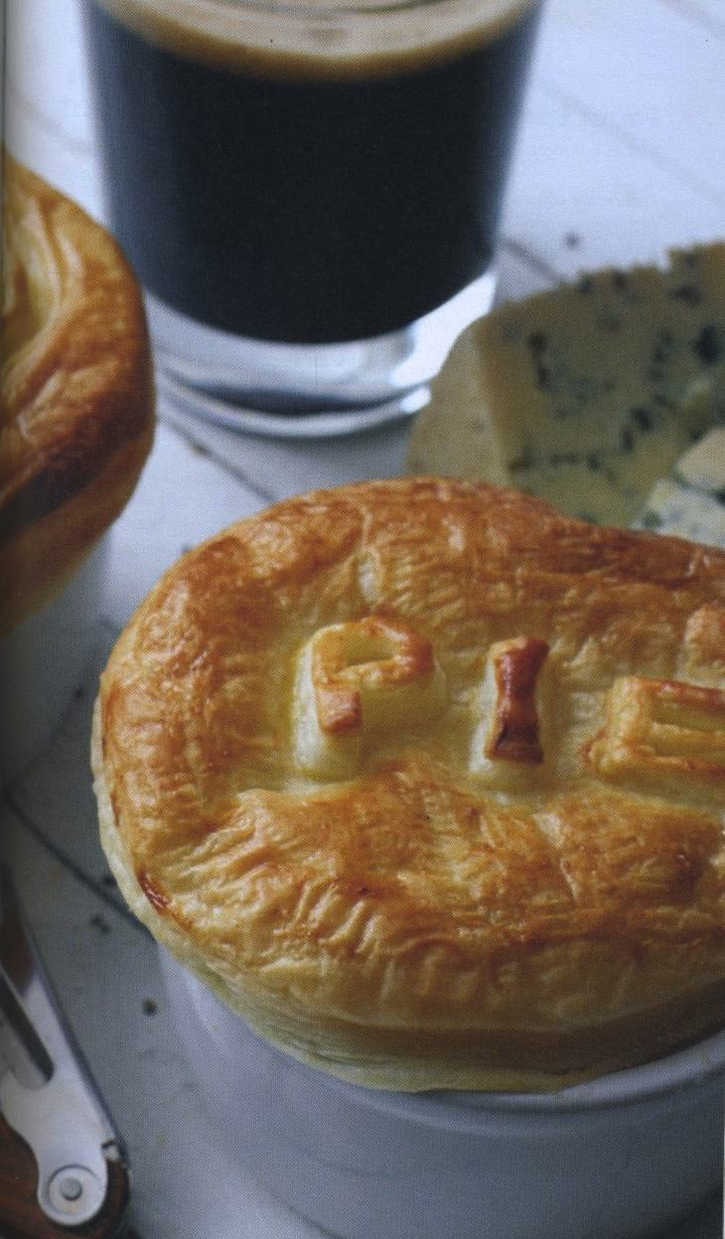 Beef, Beer and Blue Cheese Pot Pies
Beef, Beer and Blue Cheese Pot Pies
Serves 4-6
“There is nothing wrong with a classic beef and stout stew, but what if you upped the ante on the stout and added some blue cheese too? And what if you capped it with a flaky puff pastry lid and called it a pot pie instead? Now you're talking.”
l kg stewing beef (such as shin or cheek), cut into bite-sized pieces
salt and freshly ground black pepper
3 tablespoons plain flour
rapeseed or olive oil
2 red onions, chopped
2 carrots, peeled and chopped
3 garlic cloves, chopped
1 teaspoon chopped fresh thyme leaves (or l teaspoon dried thyme)
500ml stout
125g crumbled blue cheese
1 sheet of ready-rolled puff pastry
1 egg, beaten
Preheat the oven to 130°C.
Put the beef in a large bowl and sprinkle over 1 teaspoon of salt and plenty of freshly ground black pepper. Add the flour and toss the beef in it until it all has a light dusting.
Heat some rapeseed or olive oil in a large ovenproof casserole and brown the beef in batches over a medium-high heat, making sure not to crowd the pot or the meat won't brown properly. Add more oil in between batches if needed. Remove the beef from the pot and set aside.
Add another splash of oil to the pot, then add the onions and carrots along with a pinch of salt so that the onions don't brown. Cover the pot and cook for 10-15 minutes, stirring occasionally, until the vegetables are soft but not browned. Add the garlic, thyme and a generous seasoning of salt and pepper and cook for 1 or 2 minutes more.
Pour in the stout, scraping up any browned bits that have stuck to the bottom of the pot. Return the beef to the pot and bring up to a lively simmer, then cover and put in the oven for 3-4 hours (or simmer on the stovetop on a low heat with the lid on), stirring a few times.
You will know it's done when the beef easily falls apart when you prod it with a fork and the stout has reduced right down - it's a pot pie filling, not a stew, so you want it to be nice and thick. Stir in the cheese, then taste it and adjust the seasoning if necessary.
Raise the temperature to190º. Place one large ovenproof pie dish or individual dishes or ramekins onto a baking tray just in case any filling bubbles up and over the sides; then spoon the stew into the dish(es).
Roll out the pastry a little on a lightly floured counter top, then cut to fit the top of the dish. Rub the edge of the dish with a little water or some of the beaten egg to help the pastry stick in place, then place the pastry lid on top. Brush the pastry with the beaten egg (not too much or the pastry won’t rise properly), then cook in the oven for 20-30 minutes, until the pastry has risen and is golden.
Allow to stand for 10 minutes before digging in.
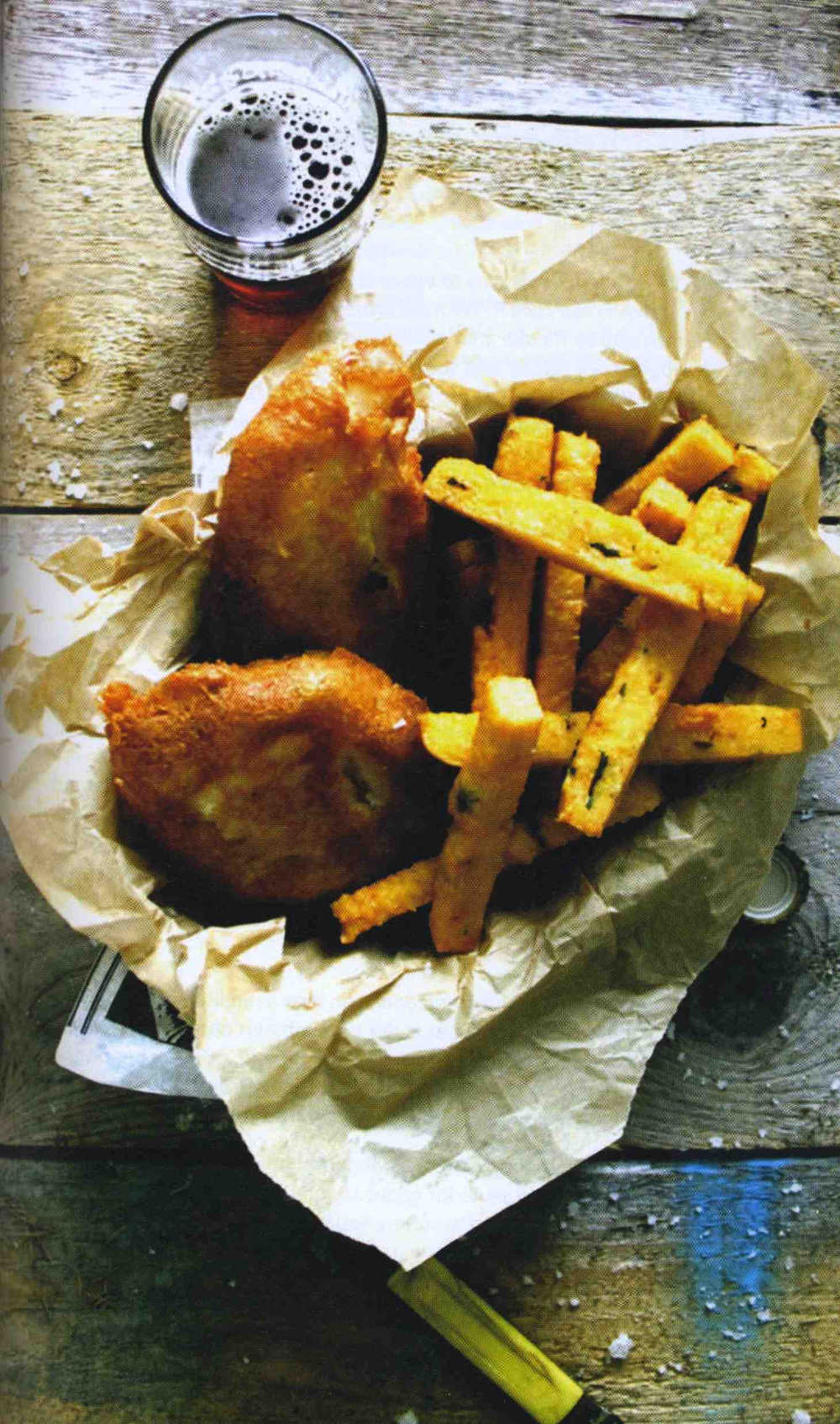 Irish Ale-Battered Fish with Chickpea Chips and Lemon Aioli
Irish Ale-Battered Fish with Chickpea Chips and Lemon Aioli
Serves 4-6
“Imen McDonnell was working in television production in America when an Irish farmer on holidays unexpectedly swept her off her feet. She married him, and she now lives on his family farm in Co. Limerick and has made a name for herself in the Irish food scene. Imen writes the Farmette blog and a weekly column for Irish Country Living, directed and produced the short film Small Green Fields about Irish food, and her first cookbook The Farmette Cookbook: Recipes and Adventures from My Life on an Irish Farm came out in the autumn of 2015 (See Darina Allen’s column this month for further details).
We love her fresh twists on Irish classics, like this version of fish and chips, but with an Irish craft ale batter and chickpea chips instead of the usual potato. This makes a lot of chips, depending on how thinly you cut them, so you could probably get away with halving the recipe and still have plenty for four greedy adults.
As for the beer, the more flavourful the ale is, the more flavourful the beer batter will be. Good ones to try are O'Hara's Irish Pale Ale or even Helvick Gold from Dungarvan Brewing.”
For the beer-battered fish:
225g self-raising flour
1 egg, lightly whisked
375ml chilled pale ale
salt and freshly ground black pepper
vegetable oil, to deep-fry
8 x 120g white fish fillets (such as cod or hake)
lemon wedges, to serve
For the chickpea chips:
425g gram flour (aka chickpea flour, available at natural food stores)
170g medium-ground maize meal (cornmeal), plus extra for dusting
2 garlic cloves, finely grated
2 tablespoons coarse salt?
zest of 2 lemons
large handful of fresh parsley, finely chopped
1 tablespoon finely chopped fresh rosemary
vegetable oil, for frying
For the lemon aioli:
150g mayonnaise
1 garlic clove, minced
3 tablespoons lemon juice
½ teaspoon lemon zest
sea salt and freshly ground black pepper, to taste
First, make the chickpea chips. Combine the gram flour, maize meal, garlic, salt and 1.6 litres of cold water in a stainless steel pot over a high heat. Whisk gently to prevent it from sticking on the bottom, but don't over-whisk it or the final product will 'souffle' and fall.
Once the mixture begins to thicken and bubble (after about 3-4 minutes), reduce the heat to medium and switch to a rubber spatula. Stir in the lemon zest, parsley and rosemary and continue stirring to prevent it from sticking. When the mixture pulls away from the sides of the pot and is becoming hard to stir (after about 6-8 minutes), transfer it to a rimmed Swiss roll tray lined with non-stick parchment paper and spread it out evenly. If it is too thick to spread with the spatula, let it cool just enough so that you can touch it, then run your hands under the tap and press it out evenly with your damp palms. Cover with a sheet of plastic wrap and top with another baking tray. Refrigerate for 4 hours, until completely cold and set.
Carefully remove the slab from the tray by gently lifting the bottom layer of parchment paper onto a cutting board. Remove the plastic wrap, then cut into chips about 8cm long.
Add a few centimetres of vegetable oil to a large saucepan. Heat the oil to 190°C over a high heat - when the oil is ready, a cube of bread dropped into if will turn golden brown in 10 seconds. Lower the heat to medium, toss the chips lightly in some extra maize meal and deep-fry them in small batches until crispy, about 2 minutes per side. Remove and drain on a plate lined with kitchen paper and keep warm.
To make the lemon aioli, simply mix all the ingredients together in a medium bowl.
To prepare the fish, place the flour in a bowl. Add the egg and stir to combine. Gradually whisk in the beer until the batter is smooth, then season with salt and pepper. Cover and place in the fridge for 30 minutes to rest.
Add enough vegetable oil to a large saucepan to reach a depth of about 4cm, or enough oil so that it reaches at least halfway up the sides of the fish fillets. Heat the oil to 190°C over a high heat - when the oil is ready a cube of bread dropped into it will turn golden brown in 10 seconds.
Dip 2 pieces of fish into the batter to coat them and quickly slide them into the hot oil before too much batter drips away. Deep-fry for 3-4 minute on each side, until golden brown, crispy and cooked through. Don't be tempted to move the fish around in the pan during that time or the batter might slide off.
Transfer to a plate lined with kitchen paper. Repeat in 3 more batches with the remaining fish and batter, reheating the oil between batches.
Serve the fish with the chickpea chips and the lemon aioli as a dipping sauce and lemon wedges on the side.
Sláinte!





There are currently no comments
Leave a comment
Not a member? Register for your free membership now!
Or leave a comment by logging in with: